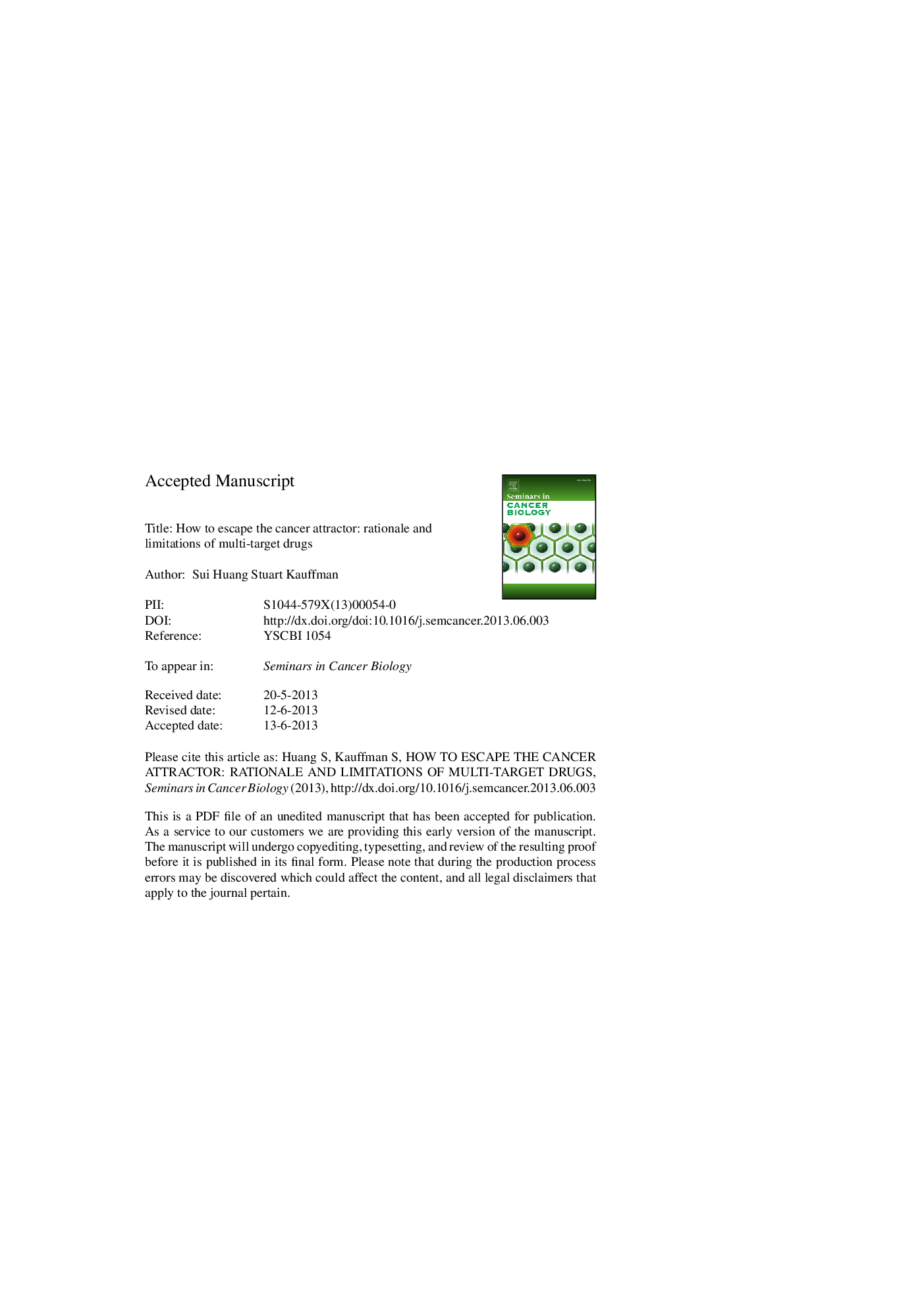| کد مقاله | کد نشریه | سال انتشار | مقاله انگلیسی | نسخه تمام متن |
|---|---|---|---|---|
| 10845625 | 1069794 | 2013 | 18 صفحه PDF | دانلود رایگان |
عنوان انگلیسی مقاله ISI
How to escape the cancer attractor: Rationale and limitations of multi-target drugs
ترجمه فارسی عنوان
چگونگی فرار از جذب سرطان: مبانی و محدودیت های داروهای چند هدف
دانلود مقاله + سفارش ترجمه
دانلود مقاله ISI انگلیسی
رایگان برای ایرانیان
کلمات کلیدی
جذب سرطان، شبکه نظارتی ژنی، چند هدف درمان، پویایی شبکه، چشم انداز اپی ژنتیکی،
ترجمه چکیده
محدودیت فزاینده آشکار درمان سرطانی هدفمند موجب برانگیختن ایده هایی برای غلبه بر توسعه مقاومت و عود می شود؛ علت اصلی جهانی برای نارسایی های درمانی که از داروهای انتخابی هدفمند معاف نیست. یک رویکرد به طور گسترده پیشنهاد شده برای تسخیر مقاومت درمانی، این است که از تمرکز نزدیک بینی بر مسیرهای علمی جدا شود و به جای آن چندین گره را در شبکه تنظیم کننده ژن سلول سرطانی هدف قرار دهد. با این حال، اکثر ایده ها به یک مفهوم سازی ساده از شبکه ها متکی هستند: تنها با استفاده از توپولوژی آنها و درمان آن به عنوان نمایش تعاملات علی، در حالی که نادیده گرفتن پویایی یکپارچه در فضای دولت. در اینجا چارچوب کلی رسمی خود را از دینامیک شبکه جهانی مرور می کنیم که در آن سلول های سرطانی، مانند سلول های معمولی سلول، حالت های جذب سطحی هستند. سپس درمان به وسیله اختلال در شبکه نشان داده می شود که خروج از چنین جاذب های سرطانی را ترویج می دهد و یک جذب طبیعی را دوباره وارد می کند. در این بحث کیفی و قابل دسترس نشان داده شده است که چگونه ایده یک منظر شبه پتانسیل بالقوه و تئوری مسیر کوچکترین مسیر، یک درک رسمی جدید برای محاسبه مجموعه ای از گره های شبکه (اهداف مولکولی) ارائه می دهد که باید در کنسرت ها مورد هدف قرار گیرد جهت خروج از جذب سرطان. اما هدف قرار دادن سلول های سرطانی بر اساس پیکربندی شبکه از یک میانگین؟ سلول سرطانی، با این حال دقیق، ممکن است برای ریشه کن کردن همه سلول های تومور به دلیل ناهمگونی پویا غیر ژنتیکی سلول های سرطانی که باعث می شود آنها اهداف را در حال حرکت و دوباره پر کردن جذب سرطان با سلول های باقی مانده و غیر پاسخ دهنده از جذب غیر طبیعی همسایه .
موضوعات مرتبط
علوم زیستی و بیوفناوری
بیوشیمی، ژنتیک و زیست شناسی مولکولی
زیست شیمی
چکیده انگلیسی
The increasingly evident limitations of target-selective cancer therapy has stimulated a flurry of ideas for overcoming the development of resistance and recurrence - the near universal reason for therapy failure from which target-selective drugs are not exempt. A widely proposed approach to conquer therapy resistance is to depart from the myopic focus on individual causal pathways and instead target multiple nodes in the cancer cell's gene regulatory network. However, most ideas rely on a simplistic conceptualization of networks: utilizing solely their topology and treating it as a display of causal interactions, while ignoring the integrated dynamics in state space. Here, we review the more encompassing formal framework of global network dynamics in which cancer cells, like normal cell types, are high-dimensional attractor states. Then therapy is represented by the network perturbation that will promote the exit from such cancer attractors and reentering a normal attractor. We show in this qualitative and accessible discussion how the idea of a quasi-potential landscape and the theory of least-action-path offer a new formal understanding for computing the set of network nodes (molecular targets) that need to be targeted in concert in order to exit the cancer attractor. But targeting cancer cells based on the network configuration of an “average” cancer cell, however precise, may not suffice to eradicate all tumor cells because of the dynamic non-genetic heterogeneity of cancer cell populations that makes them moving targets and drives the replenishment of the cancer attractor with surviving, non-responsive cells from neighboring abnormal attractors.
ناشر
Database: Elsevier - ScienceDirect (ساینس دایرکت)
Journal: Seminars in Cancer Biology - Volume 23, Issue 4, August 2013, Pages 270-278
Journal: Seminars in Cancer Biology - Volume 23, Issue 4, August 2013, Pages 270-278
نویسندگان
Sui Huang, Stuart Kauffman,
